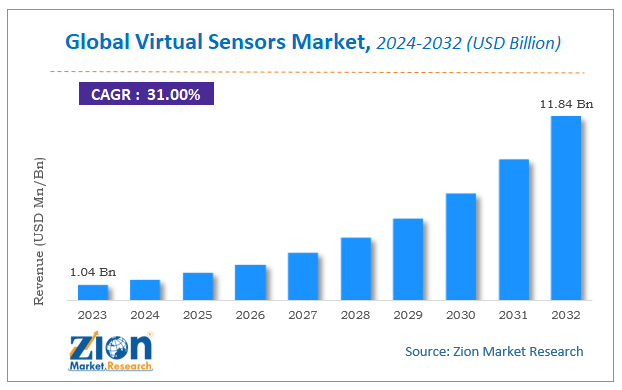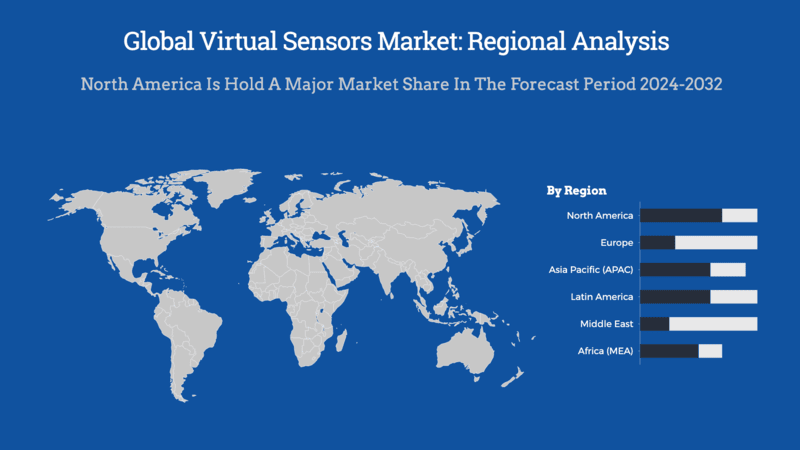Virtual Sensors Market Size, Share, And Growth Report 2032

Virtual Sensors Market By Deployment (On-Premises and Cloud-Based), By Component (Services and Solutions), and By End-User (Oil & Gas, Electrical, Electronics, & Consumer Goods, Healthcare, Chemical, Manufacturing & Utilities, Automotive & Transportation, and Others): Global Industry Perspective, Comprehensive Analysis, and Forecast, 2024-2032
| Market Size in 2023 | Market Forecast in 2032 | CAGR (in %) | Base Year |
|---|---|---|---|
| USD 1.04 Billion | USD 11.84 Billion | 31% | 2023 |
Global Virtual Sensors Market Insights
The global Virtual Sensors market size was worth around USD 1.04 billion in 2023 and is predicted to grow to around USD 11.84 billion by 2032 with a compound annual growth rate (CAGR) of roughly 31% between 2024 and 2032. The study provides historical data from 2018 to 2022 along with a forecast from 2024 to 2032 based on revenue (USD billion). The report covers a forecast and an analysis of the Virtual Sensors market on a global and regional level.
Global Virtual Sensors Market: Overview
A virtual sensor is used for the estimation of process conditions or product properties with the help of mathematical models. These models help companies in estimating the desired values by using information gathered from different physical sensors. A virtual sensor network is formed by a group of sensors, where the nodes are given certain high-speed tasks that play a crucial role in the virtual sensors market. The rising demand for virtualization architecture in wireless sensor networks (WSN) is anticipated to create lucrative market opportunities over the forecast timeframe.
The growing use of virtual IoT sensors is increasing the insights and analytics to solve real-time problems, which is primarily driving the virtual sensors market globally. The rising investments in IoT technology have paved the way for the high adoption of virtual sensors. Virtual IoT sensors are software-based Windows or Linux services that read the information on different physical sensors over a motherboard and post them on a cloud system. The manufacturing sector is anticipated to fuel the IoT network connections growth, which will drive the virtual sensors market over the upcoming years. The increasing adoption of virtual sensors worldwide is still in the initial state. Thus, the lack of awareness about the associated benefits of virtual sensors and a shortage of skilled workforce with expertise and technical knowledge may hinder the virtual sensors market growth in the years ahead.
Key Insights
- As per the analysis shared by our research analyst, the global Virtual Sensors Market is estimated to grow annually at a CAGR of around 31% over the forecast period (2024-2032).
- In terms of revenue, the global Virtual Sensors Market size was valued at around USD 1.04 Billion in 2023 and is projected to reach USD 11.84 Billion by 2032.
- Based on the deployment, the on-premise deployment segment dominated the virtual sensors market, holding approximately 67% market share. This preference is driven by organizations' desire for enhanced control and security over their virtual sensor implementations, particularly in data-sensitive industries such as finance, military, and healthcare. On-premise solutions allow for greater customization and direct control over data, reducing risks associated with third-party breaches.
- Based on the component, The solutions segment led the market in 2024, accounting for 80% of the market share. This dominance is attributed to the essential role of virtual sensor solutions in data collection and analysis, enabling organizations to monitor processes effectively and improve operational efficiency. The increasing demand for integrated systems that combine hardware and software capabilities has further solidified the solutions segment's position.
- Based on the end-user, the manufacturing and utilities sector held the largest market share in the virtual sensors market. This growth is primarily due to the high demand for real-time data and monitoring systems among industry verticals. Manufacturers are adopting virtual sensor technology, along with Artificial Intelligence (AI) and IoT, to facilitate easy prototyping, process optimization, and remote monitoring, thereby enhancing productivity and operational efficiency.
- Based on the region, North America commanded a 36% revenue share in the virtual sensors market. This leading position is due to the region's strong presence in industries such as healthcare, automotive, manufacturing, and oil & gas, where virtual sensors are increasingly utilized for process optimization, predictive maintenance, and data-driven decision-making. High technological adoption, significant investments in IoT infrastructure, and a strong focus on innovation further contribute to the region's dominance.
Virtual Sensors Market: Dynamics
Key Growth Drivers
The virtual sensors market is experiencing significant growth driven by the increasing adoption of Industry 4.0 and the growing need for real-time data analytics across various industries. Virtual sensors offer a cost-effective and efficient alternative to physical sensors by using advanced algorithms and machine learning to estimate data from existing sensor inputs. The rising demand for predictive maintenance in manufacturing, automotive, and aerospace sectors further fuels market growth. Additionally, the growing use of Internet of Things (IoT) devices and digital twins in industrial applications enhances the need for virtual sensors to optimize operations and reduce downtime.
Restraints
Despite the benefits, the virtual sensors market faces certain restraints, including the complexity of developing and deploying accurate virtual sensor models. The reliance on quality data for model training and validation can be a limitation, especially in industries with limited access to historical data. Additionally, concerns regarding data security and privacy pose significant challenges, as virtual sensors depend on large datasets and cloud-based platforms for processing. Resistance to adopting virtual sensors due to a lack of awareness and skepticism about their accuracy compared to physical sensors may also hinder market growth.
Opportunities
The expansion of smart cities and the increasing use of virtual sensors in applications such as air quality monitoring, traffic management, and energy optimization present significant growth opportunities. The growing adoption of digital twin technology in industries like healthcare, logistics, and automotive further accelerates the demand for virtual sensors. Moreover, advancements in artificial intelligence (AI) and machine learning algorithms continue to improve the accuracy and reliability of virtual sensor models, opening new possibilities for their application. Partnerships between technology providers and industries to develop customized virtual sensor solutions also offer promising opportunities.
Challenges
One of the primary challenges in the virtual sensors market is ensuring the accuracy and reliability of the sensor data models. Inconsistent or poor-quality input data can lead to incorrect predictions, impacting operational efficiency and decision-making. Additionally, the lack of standardized frameworks for virtual sensor implementation creates difficulties in cross-industry adoption. Integrating virtual sensors with existing legacy systems can also be challenging, requiring additional investments and technical expertise. Furthermore, competition from established physical sensor manufacturers and the need for continuous algorithm updates to adapt to changing environments remain key challenges for the market.
Virtual Sensors Market: Report Scope
| Report Attributes | Report Details |
|---|---|
| Report Name | Virtual Sensors Market |
| Market Size in 2023 | USD 1.04 Billion |
| Market Forecast in 2032 | USD 11.84 Billion |
| Growth Rate | CAGR of 31% |
| Number of Pages | 202 |
| Key Companies Covered | Cisco, ANDATA, Elliptic Laboratories, Honeywell Process, Algorithmica Technologies, IntelliDynamics, Schneider Electric, LMI Technologies, Modelway, OSIsoft, Aspen Technology, and Siemens |
| Segments Covered | By Deployment, By Component, By End-User And By Region |
| Regions Covered | North America, Europe, Asia Pacific (APAC), Latin America, Middle East, and Africa (MEA) |
| Base Year | 2023 |
| Historical Year | 2018 to 2022 |
| Forecast Year | 2024 - 2032 |
| Customization Scope | Avail customized purchase options to meet your exact research needs. Request For Customization |
Virtual Sensors Market: Segmentation
The global virtual sensors market is segmented on the basis of deployment, component, end-user, and region. All the segments have been analyzed based on present and future trends and the market is estimated from 2024 to 2032.
On the basis of deployment, the market is majorly classified into on-premises and cloud-based.
By component, the market includes services and solutions. Virtual sensor solutions are highly preferred by organizations for estimating different product properties, which is and fuelling the solutions segment growth in the global market.
The end-user segment of the global virtual sensors market includes electrical, electronics, and consumer goods, oil and gas, healthcare, manufacturing and utilities, chemical, automotive and transportation, and others. The electronics, electrical, and consumer goods industry is likely to hold a major market share in the future, owing to the growing virtual sensors demand due to unique and complex product designs.
The regional segment includes the current and forecast demand for North America, Europe, Asia Pacific, Latin America, and the Middle East and Africa.
Virtual Sensors Market: Regional Analysis
The regional segment includes the current and forecast demand for North America, Europe, Asia Pacific, Latin America, and the Middle East and Africa. North America dominated the virtual sensors market in 2023 and is anticipated to hold the largest market share globally in the upcoming years as well. This can be attributed to the presence of prominent market players in the region.
The virtual sensors market is experiencing significant growth globally, with regional variations influenced by technological adoption, industrial needs, and economic factors. Below is a regional analysis highlighting key trends and projections:
North America
North America leads the virtual sensors market, accounting for approximately 37.6% of global revenue in 2024. This dominance is attributed to advanced technological infrastructure and high adoption rates across industries such as manufacturing, healthcare, and automotive. The integration of virtual sensors with the Industrial Internet of Things (IIoT) is a critical growth driver. In the United States, the presence of major technology companies and supportive government initiatives promoting smart manufacturing and energy efficiency further bolster market expansion.
Europe
Europe represents a mature market with strong adoption in manufacturing, automotive, and industrial sectors. Countries like Germany, France, the United Kingdom, and Italy contribute significantly to regional growth. The region's focus on sustainability and energy efficiency drives demand for virtual sensor solutions to monitor environmental conditions and optimize resource usage. Advancements in artificial intelligence and machine learning are enhancing virtual sensor capabilities, supporting applications in healthcare, automotive, and smart cities.
Asia-Pacific
The Asia-Pacific region is poised for rapid growth in the virtual sensors market, driven by industrialization and increasing investments in smart technologies. China, India, and Japan are key contributors, with China's strong manufacturing base and commitment to technological advancement leading the way. Government initiatives promoting Industry 4.0 and smart city projects are accelerating adoption. The region's emphasis on automation and IoT integration positions virtual sensors as cost-effective alternatives to traditional physical sensors.
Middle East, Africa, and Latin America
These regions are witnessing growing adoption of virtual sensor technologies, particularly in oil and gas, utilities, and smart agriculture sectors. Investments in industrial automation, IoT technologies, and digital transformation initiatives are key growth drivers. Government initiatives and smart city projects further stimulate market expansion, positioning virtual sensors as integral to sustainable development agendas.
Virtual Sensors Market: Competitive Players
Some renowned players of the virtual sensors market are:
- Cisco
- ANDATA
- Elliptic Laboratories
- Honeywell Process
- Algorithmica Technologies
- IntelliDynamics
- Schneider Electric
- LMI Technologies
- Modelway
- OSIsoft
- Aspen Technology
- Siemens
The Global Virtual Sensors Market is segmented as follows:
Virtual Sensors Market: Deployment Analysis
- On-Premises
- Cloud-Based
Virtual Sensors Market: Component Analysis
- Services
- Solutions
Virtual Sensors Market: End-User Analysis
- Oil and Gas
- Electrical, Electronics and Consumer Goods
- Healthcare
- Chemical
- Manufacturing and Utilities
- Automotive and Transportation
- Others
Virtual Sensors Market: Regional Analysis
- North America
- The U.S.
- Europe
- UK
- France
- Germany
- Asia Pacific
- China
- Japan
- India
- Latin America
- Brazil
- Middle East and Africa
Table Of Content
Methodology
FrequentlyAsked Questions
A virtual sensor is used for the estimation of process conditions or product properties with the help of mathematical models.
According to study, the Virtual Sensors Market size was worth around USD 1.04 billion in 2023 and is predicted to grow to around USD 11.84 billion by 2032.
The CAGR value of Virtual Sensors Market is expected to be around 31% during 2024-2032.
North America has been leading the Virtual Sensors Market and is anticipated to continue on the dominant position in the years to come.
The Virtual Sensors Market is led by players like Cisco, ANDATA, Elliptic Laboratories, Honeywell Process, Algorithmica Technologies, IntelliDynamics, Schneider Electric, LMI Technologies, Modelway, OSIsoft, Aspen Technology, and Siemens.
RelatedNews
HappyClients
Zion Market Research
Tel: +1 (302) 444-0166
USA/Canada Toll Free No.+1 (855) 465-4651
3rd Floor,
Mrunal Paradise, Opp Maharaja Hotel,
Pimple Gurav, Pune 411061,
Maharashtra, India
Phone No +91 7768 006 007, +91 7768 006 008
US OFFICE NO +1 (302) 444-0166
US/CAN TOLL FREE +1 (855) 465-4651
Email: sales@zionmarketresearch.com
We have secured system to process your transaction.
Our support available to help you 24 hours a day, five days a week.
Monday - Friday: 9AM - 6PM
Saturday - Sunday: Closed








